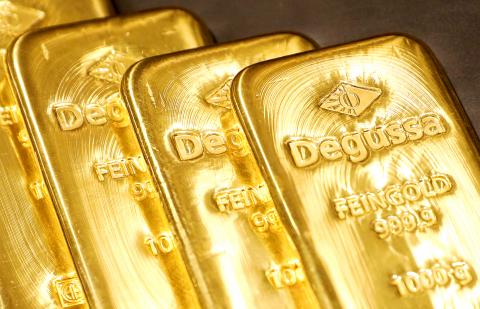Investors are rushing to the safety of gold amid a selloff in US stocks on mounting concerns the COVID-19 outbreak will derail global growth.
Gold jumped as much as 2 percent on Friday, extending its climb to a seven-year high, as the S&P 500 Index posted its first weekly loss since last month.
In a sign that the virus is starting to dent the world’s largest economy, business activity in the US shrank this month for the first time since 2013 with the outbreak disrupting supply chains.

Photo: Reuters
“The persistent, cold-blooded and measured shift in gold higher, despite the US dollar, is telling,” Bank of Nova Scotia metals strategist Nicky Shiels said in e-mailed message. “The breakout is warranted and has legs.”
Gold futures for April delivery rose 1.7 percent to settle at US$1,648.80 an ounce at on the Comex in New York, the highest closing price for a most-active contract since February 2013.
The metal notched a 3.9 percent gain this week, the biggest increase since June last year.
“Gold is in the midst of its perfect storm,” Saxo Bank A/S head of commodity strategy Ole Hansen said.
Prices of bullion in euros as well as Australian and Canadian dollars climbed to records.
Holdings in gold-backed exchange traded funds (ETFs) climbed for 22 straight sessions through Thursday, the longest-ever run, according to data compiled by Bloomberg.
The amount of call options traded in a single day spiked to the highest ever in records dating to 1996, preliminary data showed.
The stretch of inflows “certainly gives an indication about concerns around the global economy,” Andrew Jamieson, global head of ETF product at Citigroup Inc in London, said in an interview with Bloomberg TV.
The outbreak has worsened outside of China, while a jump in cases in Iran is also raising concern.
Chinese authorities adjusted the number of cases for the third time this month, raising more questions over the reliability of the data.
In more than half of the world’s 20 biggest economies, analysts now expect looser budgets this year — in other words, bigger deficits or smaller surpluses — than they did six months ago, a Bloomberg survey of economist forecasts showed.
The Commonwealth Bank of Australia expects the US Federal Reserve to ease twice in the second half of the year as the outbreak threatens the global economy.
Still, lower US yields and weaker equities could push gold prices further toward US$1,750 an ounce even if the outbreak is contained during the first quarter, Goldman Sachs Group Inc has said.
If the outbreak stretches beyond that, “we see substantially more upside from here — toward US$1,850 an ounce, depending on the magnitude of the global monetary policy response,” the bank said in a note on Friday.
Other precious metals:
‧Silver futures climbed on the Comex.
‧On the New York Mercantile Exchange, palladium futures rose, while platinum futures declined.

CHIP RACE: Three years of overbroad export controls drove foreign competitors to pursue their own AI chips, and ‘cost US taxpayers billions of dollars,’ Nvidia said China has figured out the US strategy for allowing it to buy Nvidia Corp’s H200s and is rejecting the artificial intelligence (AI) chip in favor of domestically developed semiconductors, White House AI adviser David Sacks said, citing news reports. US President Donald Trump on Monday said that he would allow shipments of Nvidia’s H200 chips to China, part of an administration effort backed by Sacks to challenge Chinese tech champions such as Huawei Technologies Co (華為) by bringing US competition to their home market. On Friday, Sacks signaled that he was uncertain about whether that approach would work. “They’re rejecting our chips,” Sacks

NATIONAL SECURITY: Intel’s testing of ACM tools despite US government control ‘highlights egregious gaps in US technology protection policies,’ a former official said Chipmaker Intel Corp has tested chipmaking tools this year from a toolmaker with deep roots in China and two overseas units that were targeted by US sanctions, according to two sources with direct knowledge of the matter. Intel, which fended off calls for its CEO’s resignation from US President Donald Trump in August over his alleged ties to China, got the tools from ACM Research Inc, a Fremont, California-based producer of chipmaking equipment. Two of ACM’s units, based in Shanghai and South Korea, were among a number of firms barred last year from receiving US technology over claims they have

It is challenging to build infrastructure in much of Europe. Constrained budgets and polarized politics tend to undermine long-term projects, forcing officials to react to emergencies rather than plan for the future. Not in Austria. Today, the country is to officially open its Koralmbahn tunnel, the 5.9 billion euro (US$6.9 billion) centerpiece of a groundbreaking new railway that will eventually run from Poland’s Baltic coast to the Adriatic Sea, transforming travel within Austria and positioning the Alpine nation at the forefront of logistics in Europe. “It is Austria’s biggest socio-economic experiment in over a century,” said Eric Kirschner, an economist at Graz-based Joanneum

BUBBLE? Only a handful of companies are seeing rapid revenue growth and higher valuations, and it is not enough to call the AI trend a transformation, an analyst said Artificial intelligence (AI) is entering a more challenging phase next year as companies move beyond experimentation and begin demanding clear financial returns from a technology that has delivered big gains to only a small group of early adopters, PricewaterhouseCoopers (PwC) Taiwan said yesterday. Most organizations have been able to justify AI investments through cost recovery or modest efficiency gains, but few have achieved meaningful revenue growth or long-term competitive advantage, the consultancy said in its 2026 AI Business Predictions report. This growing performance gap is forcing executives to reconsider how AI is deployed across their organizations, it said. “Many companies